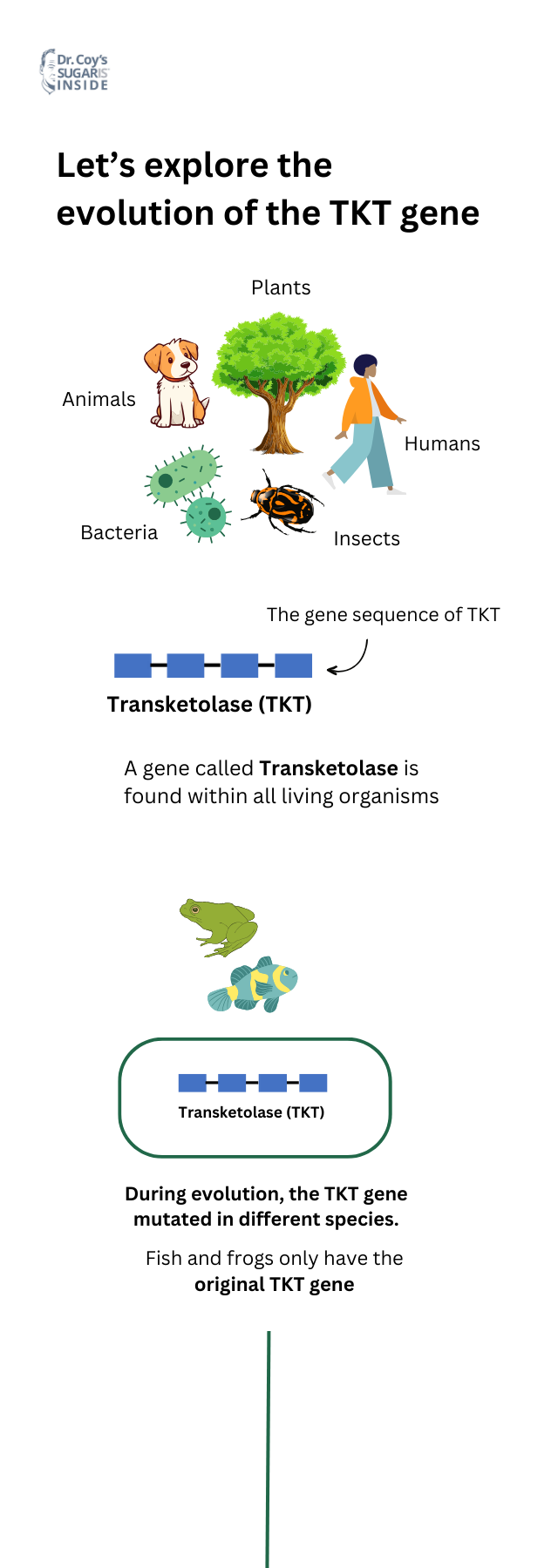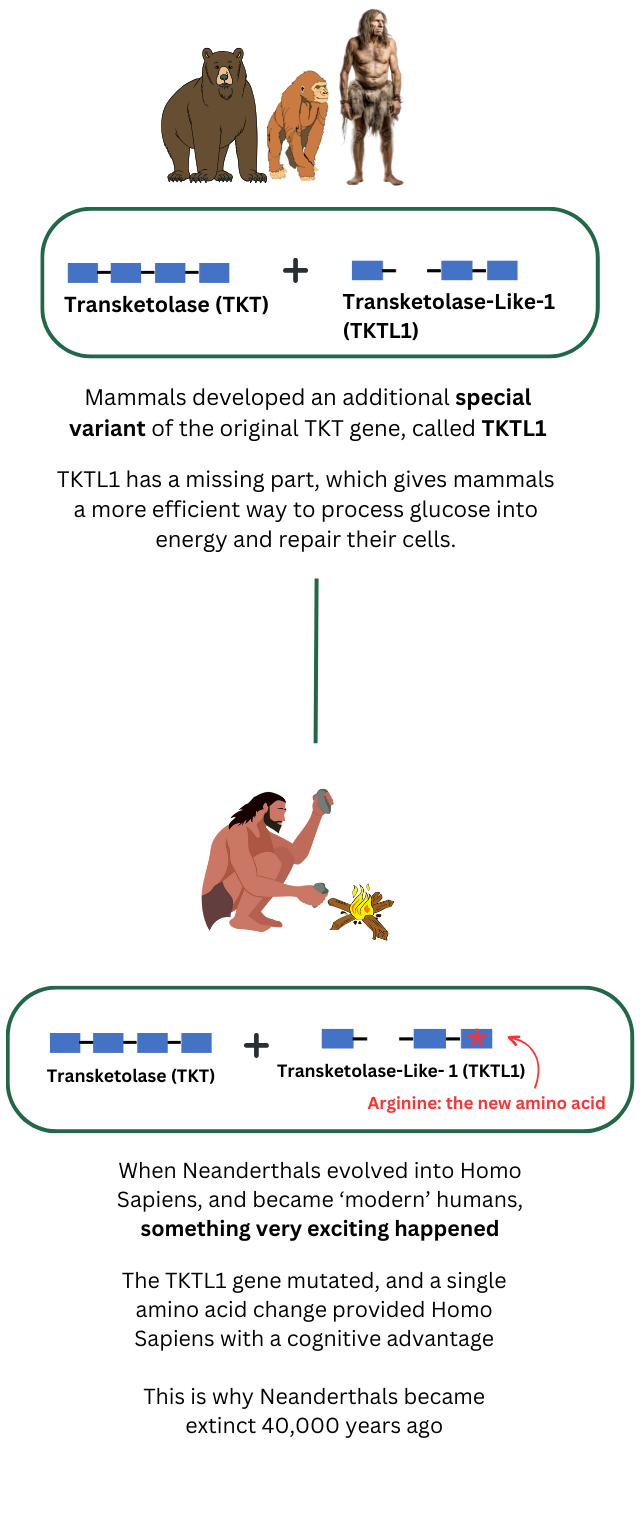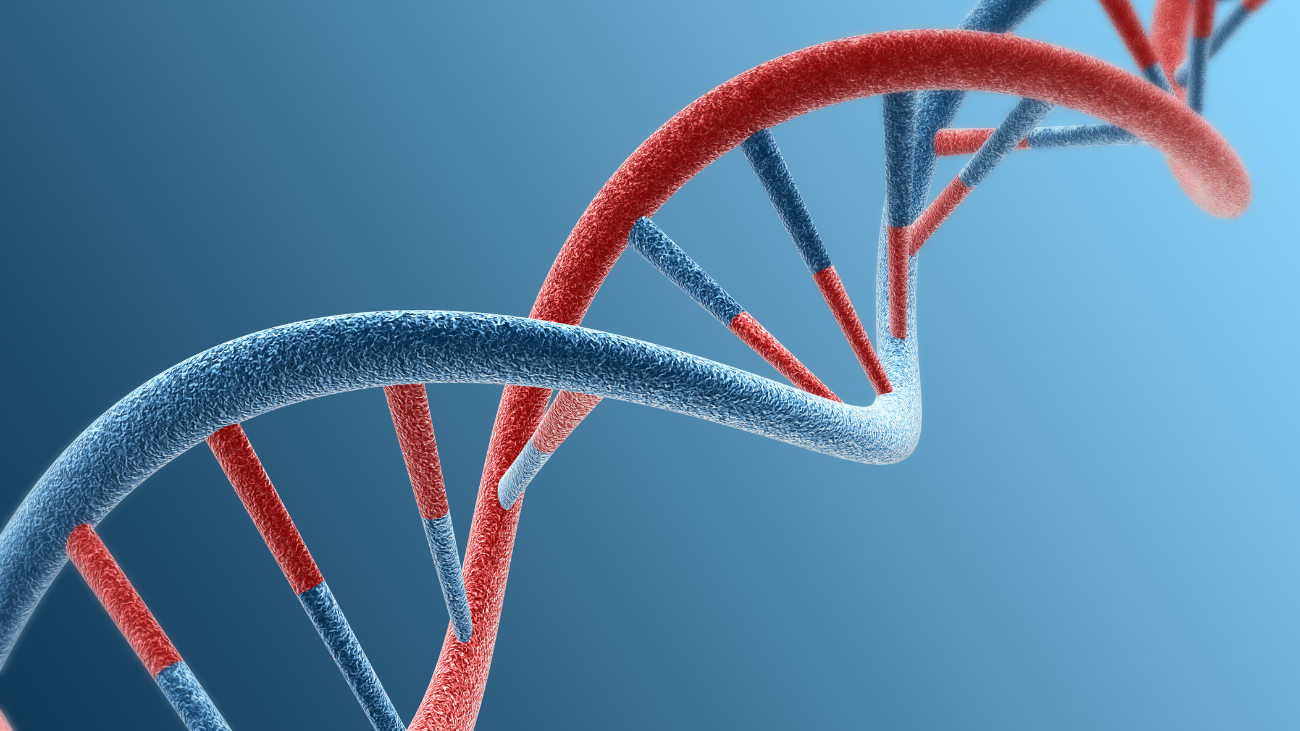Out of the thousands of genes in our body, TKTL1 is the one gene you should care about.
TKTL1 is a special gene that emerged during the evolution of mammals. Numerous genetic changes optimized this gene, and the enzyme it created, over the course of 300 million years.
It is responsible for the evolution of our advanced intelligence and the generation of new cells in our body. We’ve only known about this gene for the past 28 years, and recent research is revealing the intrinsic link between TKTL1 and the rise in modern lifestyle diseases such as diabetes, Alzheimer’s, and cancer.
In 1995, Dr Johannes Coy, a renowned biochemist, discovered TKTL1. His interest in the Warburg Effect and our sugar metabolism led him to his ‘eureka’ moment in the lab. As groundbreaking findings from Nobel Laureate, Svante Pääbo, and other leading scientists from the Max Planck Society continue to confirm the importance of Dr Coy’s discovery — the TKTL1 gene is set to change the course of scientific textbooks for the better.
By understanding how a single gene operates in your body, you can lower the risk of developing diseases and improve your health and performance. You can use the recent scientific breakthroughs for improving your nutrition to enable an energized lifestyle and optimizing your body weight without giving up your favourite foods.
What exactly is TKTL1?
Let’s start at the very beginning.
In all living organisms, from plants and bacteria to humans and insects, there is a gene called Transketolase. It is in charge of managing the production of building blocks for new DNA for all the cells in living things. However, some animals have a special variant of this gene, which they gained during evolution.
For example, fish, reptiles, and frogs only have Transketolase (TKT). But all mammals, such as lions and bears, have an additional special variant of TKT, called Transketolase-like 1 (TKTL1).
This TKTL1 gene is a copy of TKT, and the following genetic mutation led to a very special enzyme with transketolase functions and novel enzymatic properties – never before seen in any transketolase gene.
The TKTL1 gene allows a mammal’s body to choose the optimal pathway to process glucose, by either turning it into energy, or using it to repair and heal the body. In contrast to the well-known biochemical pathway (Embden-Meyerhof pathway and the enzyme Pyruvate dehydrogenase) enabling the conversion of glucose into fat and other building blocks, TKTL1 enabled a much more efficient way of converting glucose to fat – 100% of glucose could be converted to fat instead of only 66% in non-mammal animals.
This was critical, 66 million years ago, during the meteor strike that wiped out the dinosaurs. Since dinosaurs are reptiles, they did not have this advantage of the TKTL1 gene. Their bodies could not efficiently use glucose to fuel the creation of necessary building blocks for fat and survive the drastic living conditions. Small mammals were able to use the glucose stored in the starch of plants and grains in a highly efficient way, but dinosaurs had to struggle with reduced plant growth and less glucose as a result of the dust darkening the atmosphere caused by the meteor.
The TKTL1 gene didn’t mutate again for a long time, until the Neanderthals appeared. Since Neanderthals are mammals, they had the TKT gene plus TKTL1. When Homo Sapiens evolved, something very exciting happened.
The TKTL1 gene finally mutated again – providing Homo Sapiens with a brand-new version of the transketolase-like-1 (TKTL1). This new TKTL1 gene is the defining factor differentiating Homo Sapiens from Neanderthals, as it is responsible for our cognitive advantage. Which is why Neanderthals soon died out and were overtaken by Homo Sapiens.
And what makes this new version of TKTL1 gene so different from the older version of TKTL1 in Neanderthals? A single amino acid change.
An amino acid called arginine, was able to increase the production of neurons in the brain, leading to enhanced intelligence and abilities. Because this new mutation was so advantageous, it quickly became the dominant version of the gene in Homo Sapiens and enabled the improvement of the modern human brain.


The most important change in TKTL1 was the deletion of 38 amino acids. Some of these lost amino acids are considered essential for the function of transketolases. For this reason, transketolase experts previously categorised TKTL1 as a ‘defective’ gene. Only Dr Johannes Coy believed that this deletion could be the basis for altered enzyme properties and the possibility of TKTL1 forming an enzyme complex with TKT.
In 2019, scientists discovered that TKTL1 does form a complex with TKT, thereby forming the sugar ribose, which makes the formation and repair of DNA possible. Just last year, Nobel Prize winner Svante Pääbo and colleagues from the Max Planck Society proved that the replacement of a single amino acid in the TKTL1 protein of modern humans, compared to the TKTL1 protein of Neanderthals, has altered the gene in such a way that significantly more nerve cells are formed in the brain (neocortex). Also, the folding of the cerebral cortex is stronger, creating more space for the increased number of nerve cells.
This specific change in enzymatic properties caused the TKTL1 gene to be incredibly important for the increased cognitive performance of modern humans.
Over time this super smart gene has become a major factory within our body, in charge of creating new DNA, cells, and managing our metabolism.
For millennia, TKTL1 has been beneficial to modern humans, until now.
Our modern landscape is extremely different from our days as early Homo Sapiens. Instead of being hunters and gatherers, we are office workers and Netflix watchers. Food, especially sugar, is abundant at all hours of the day.
But why is sugar added to almost all of our food?
The reason is TKTL1.
TKTL1 needs sugar to function and switch on the enzyme reactions which are converted into the essential building blocks for the formation and repair of our cells. Therefore, our brain rewards us when we give our body sugar.
For the first time we can explain why modern humans love sugar. Sugar was extremely precious and rare in the days when humans lived as hunter-gatherers. Since fat contains more than twice as much energy as sugar (glucose), it would make more sense for the brain to demand fat. But instead, our brain wants sugar. Our brain needs sugar to give TKTL1 enough fuel to produce the important building blocks for the maintenance and function of the brain.
Unfortunately, the increased amount of glucose in our diet causes the TKTL1 gene to help the growth of unwanted cells as well: fat cells, inflammatory cells and cancer cells.
The basis of Dr Coy’s research is focused on maintaining the benefits of TKTL1 for the repair of healthy cells without promoting the growth of unwanted cells. The functions of the TKTL1 gene are the core of a healthy lifestyle and the key to preventing diseases such as diabetes, Alzheimer’s, and cancer.
He discovered that TKTL1 holds two sides of one coin: a good side and a bad side. Excess sugar in our diet turns on the bad side of TKTL1, a balanced amount of sugar promotes the good side.
So now that you know what the TKTL1 gene is, and how it came to be, let’s break down how it functions in your body.
Click here to explore Part 2 to understand how TKTL1 affects us today.
Are you ready for an Intelligent Sugar Strategy?
Resources:
Anneline Pinson et al. ,Human TKTL1 implies greater neurogenesis in frontal neocortex of modern humans than Neanderthals. Science377,eabl6422(2022).



